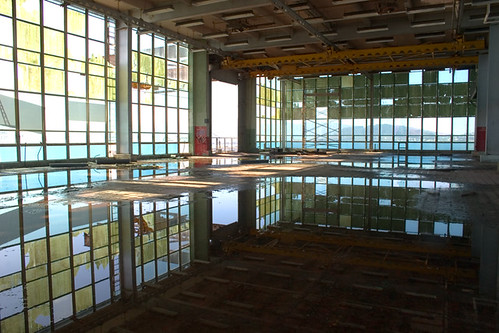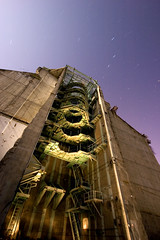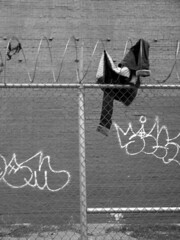A Complete Guide to Urban Exploration
By Jonathan H
 |
| photo by Jon Haeber |
We live in a post-industrial world, and our connection to the modes of production, our infrastructure, and the cogs of society is becoming more and more disembodied from day-to-day life. This guide is meant to be an introduction to one of the fastest growing hobbies our modern time: Urban Exploration.
Why?

The definition of Urban Exploration may be different for every adherent, but most urban explorers call themselves modern historians, discoverers, archivers, documentarians, and architecture buffs. Some explore for simple aesthetic reasons because they find the crumbling edifices of society to be perfect artistic subjects. Others find a certain level of adventure and excitement in exploring off-limits areas or skirting the law to reach places that most people can’t see. Still others have a purely historical interest in a specific building or complex.
Whatever the reason, Urban Exploration is something that can be traced back hundreds of years, even back to 1793, when an oft-cited “explorer,” Parisian cataphile Philibert Aspairt, became famous for his untimely death in the Catacombs under Paris. To this day, the Paris Catacombs attracts a subculture that descends underground for regular socializing and fraternizing.
How?
The methods of urban exploration, much like the motivations of its adherents, vary. Extensive research is essential for any “virgin” finds. This may often require visits to your local library or archive. Topographic and historical maps, especially Sanborn maps, provide a perfect starting point. Google Earth, Wikipedia, and Wikimapia are vital tools if you wish to get a more up-to-date snapshot of your target location.
Some Urban Explorers have a penchant for Google Alerts; by setting up an alert on Google Alerts for specific keywords, an urban explorer is continually aware of new abandonments. Geotargeted key phrases matched with the word, “abandoned,” or “vacant” also work especially well in researching new “finds.”
The best way to start exploring is to pair up with a buddy. Much like scuba diving, urban explorers are safest if they explore in small groups. Established communities online, including uer.ca, Infiltration, and Deggi5 allow you to become acquainted with like-minded explorers, some who can provide you with a valuable list of new locations to explore.
Above all, the late Jeff Chapman (who passed away in 2006 after a battle with cancer) published a posthumous book that has become the de-facto Bible of Urban Exploration. Chapman’s book, Access All Areas, provides a full summary of the basics of “Building Hacking.”
The Gear
The hobby is known for its extremely low barriers to entry. All one
needs is a flashlight, some water, and a passion to discover. Of
course, if you prefer to photograph your finds, a camera always helps,
but the lighter you travel, the better off you are. Certain treks may require more extensive gear-packs – see the Health & Safety Section for more on that.
The Methods
 |
| Image by forklift |
Methods of entry are important to decide prior to entering your target. Consult with other members in the group. Lay down ground rules as to how much climbing, crawling, and razor-wire you wish to encounter. Some groups may turn back at the first sight of a fence. Others may jump at the opportunity to try their hand at nine-foot razor-wire. Be absolutely sure of the risks you’re taking and the laws you may potentially be breaking.
Health & Safety
Urban exploration is a dangerous hobby, and it should be treated as such. Some of the more common hazards include:
- Falling from, or within, multi-story buildings.
- Inhaling dangerous fumes, gases, or particles.
- Stepping on or accidentally touching hypodermic needles from illicit drug use.
- Encroaching on the territory of gangs, drug-users, or hostile vagrants.
- Cuts, scrapes, and bruises — ensure that Tetanus shots are up-to-date.
- In the case of draining, flash floods, or even small amounts of rain could prove deadly if one is confined in a storm system.
Specialized Gear for Health & Safety
Situation |
Equipment |
|
|
|
|
|
|
|
|
Unwritten Codes of Conduct
There are a few unwritten rules in Urban Exploration, and one should be cognizant of the protocol in order to be fully accepted and trusted as a new member of the sub-culture.
The most common and oft-quoted rule follows the mantra of the Sierra Club: “Take only photographs, leave only footprints.” Though not all urban explorers follow this directive, the vast majority do. Many abandonments possess a treasure trove of esoteric objects, unique contraptions, rare industrial components, or special antique items that could sell for a handsome profit on eBay. Despite all this, the community has decided to officially condem taking any object from a building.
Graffiti and vandalism are generally condemned, but there are exceptions. It should be noted that urban explorers are a diverse group of tens of thousands, potentially hundreds of thousands. The diversity of opinions falls in both extremes, but the moderate and mean consensus generally follows the rule of law except for the very notable exception of Trespass.
As of now, there is no officially sanctioned urban exploration moral codex. In fact, “following the rules” would run counter to the central principle of exploring. For this reason, urban explorers have a general understanding of the community’s moral compass and make of it what they will.
Documentation
Most urban explorers consider the documentation of the structure or location to be their prime concern. The most notable method of documentation is by still photograph. Video, sound, and architectural sketches or rough maps are recorded to a lesser degree.
Most explorers are astute photographers, and the artistic liberty taken inside of an abandonment results in a dramatic collection of architectural photography that has only recently been possible. To most, this is the central purpose and goal of their hobby – and they hold it as a very sacred duty in order to record pieces that are often lost within months or years due to the wrecking ball.
The Law
Urban explorers are breaking the law, but it’s generally assumed that such laws are antiquated or unjust. The most notable law that is broken by an explorer is trespass, but others may come into play as well, including:
- Invasion of privacy
- Either purposeful or inadvertent destruction of property
- Certain broadly interpreted anti-terrorism laws
- Liability for the injury of others in your group
In general urban explorers are liable to be prosecuted for criminal and civil judgements for trespassing, but publishing the photographs themselves is considered a separate issue. The only exception is invasion of privacy. If an explorer publishes photos that infringe on the likeness of someone, or put them in a negative light, then he or she may be held liable for that action in civil court.
Conclusion
Urban exploration is, by nature, a very dangerous and illegal activity. At the same time, it can be a very rewarding and engaging pursuit. This guide was meant to inform you of all the safety and legal concerns so you can make an informed decision whether or not urban exploration is right for you.
Resources
The Urban Exploration Resource (Forum)
Author’s Site: Photos and Stories of Historic Architecture


 Reddit!
Reddit! Del.icio.us
Del.icio.us Digg
Digg StumbleUpon
StumbleUpon Technorati
Technorati Blinklist
Blinklist Furl
Furl
Superb summary! This is required reading. Thanks!
Thank You, Sir! It was a piece I also posted to Google Knol to test out the functions and UI. It’s actually a great little piece of work Google has put out with Knol; I’m impressed.
Ehh… not bad, but the “Specialized Gear for Health & Safety” is a bit much if you ask me. I’ve yet to meet any drainer who uses a gas detector, let alone a SCBA unit. I doubt cataphiles use such items either. Also, why would one need rock climbing gear for grain elevators? And OSHA approved training in confined spaces? Give me a break.
This is still a lot better than the current wikipedia entry for urban exploration, but I get the sense that you’re either writing about things you have no experience with or you’re just trying to play the safety card to help satisfy the general public.
Hi Andrew,
I get your take on it. I was being especially cautious in the safety section. Of course, you rarely require such gear, but the more you have in such situations, the better off you are safety-wise. In fact, I can probably count on one hand how many times I’ve even used a respirator, but I’m generally not very safe.
You also said that you’ll need a P95 mask or better for places with asbestos.
This definitely isn’t true; for asbestos, you need a P100 respirator or else you’re going to get asbestos in your lungs which’ll lead to mesothelioma.
actually, denryuu: I’ve seen some P95’s that are asbestos rated. I think it depends on which one you’re purchasing. P100 would definitely be the best bet, but I think P95 will take care of most asbestos hazards unless you’re swimming in it.
Pingback: holden beach, nc — christmas 2009 « brand new kind of photography
Pingback: The Hazards of Haikyo and Urban Exploration – Gakuranman.com
Pingback: Urban exploration | City life & art
Pingback: Guide to Success: THC Photography Workshop « Plume Noir.
Pingback: O nome do jogo é: URBEX « Meio Bit
Pingback: URBEX « Deborahpk’s Blog
Pingback: Urbex e os abandonados por aí…. « que belezinha
Pingback: KOZZAK » Archive » Deliris de l’antiga Ioguslavia
Pingback: A Picture Is Worth…pt 2 | Click Whirl Photography
Fantastic! And Thanks a lot.
I know this is a dated post, but I think this is very informative – probably the best general overview for this genre as I have ever seen. If properly credited, would you mind if I shared this on the UER rookie forum?
Hopefully you’ll see this comment, but I know it is a long shot!
Cheers,
Dee
Hi Dee. Sure, no problem. Make of it any way you wish. I’d prefer credit. Thanks for the kind words.
As someone just looking into this hobby, this guide is a very useful overview! I’ll be moving right outside of a city soon and can’t wait to explore something new. Thank you 🙂
Great Guide!
I’m just starting into the urban exploration and pages like this one or https://urbexarte.com are helping me a lot!